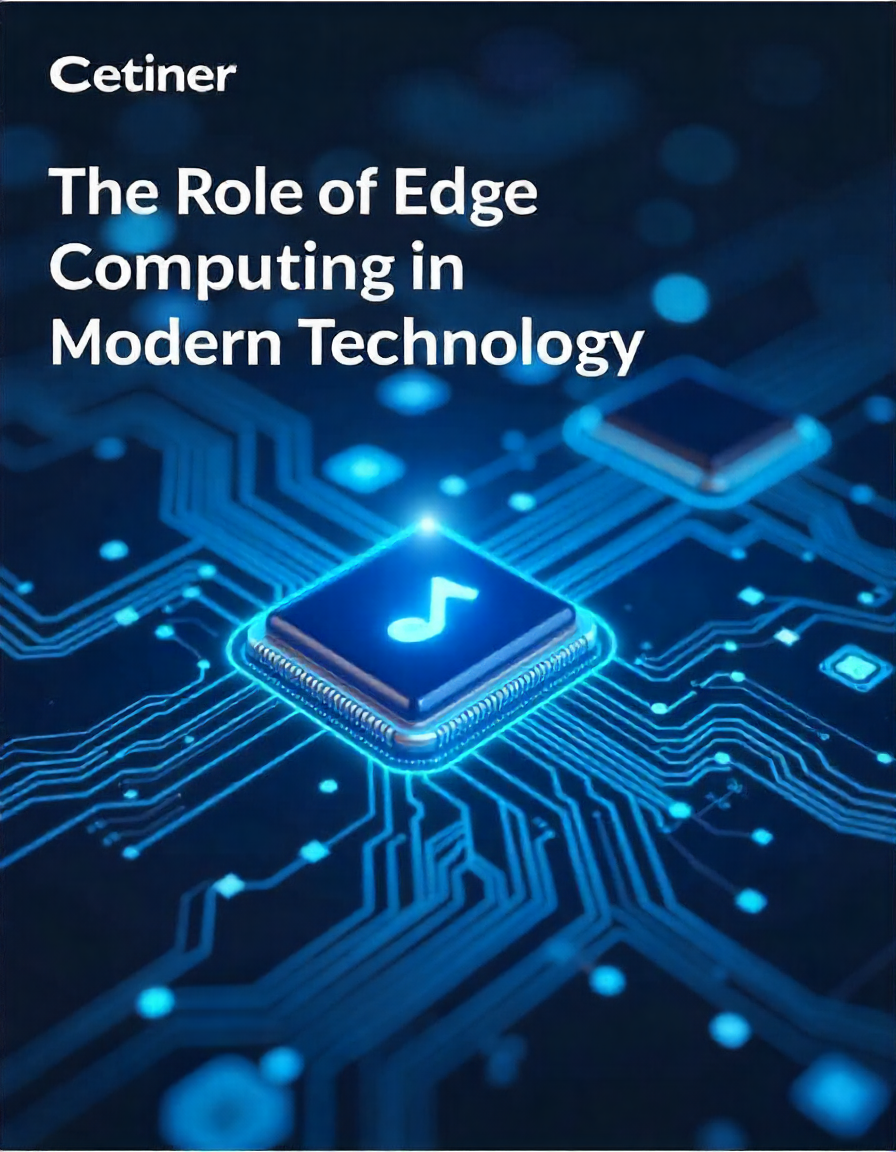The rapid digitization of the world has pushed technology to evolve at a remarkable pace. From smart cities to autonomous vehicles, modern innovations demand speed, scalability, and high-efficiency data processing. This growing need has paved the way for edge computing, a formidable technology reshaping how data is processed, analyzed, and acted upon.
Edge computing may not always grab the spotlight like artificial intelligence or blockchain, but its influence is undeniable. By bringing data processing closer to where it is generated, edge computing has revolutionized several industries. This blog explores the core principles of edge computing, its benefits, real-world applications, and how it’s transforming technology as we know it.
What Is Edge Computing?
Edge computing involves processing data at or near the source of data creation rather than relying solely on centralized data centers. Traditional cloud computing systems often require data to travel significant distances to central servers, where it is processed and returned to the originating device. This architecture can result in latency, higher bandwidth usage, and inefficiencies that limit the performance of time-sensitive applications.
Edge computing addresses these issues by decentralizing data processing. By placing computation closer to “the edge”—the devices and systems where data is generated—it enables quicker responses and optimized resource use. A practical example is a smart thermostat that adjusts home temperatures using edge processing without relying on remote servers.
Why Has Edge Computing Become a Necessity?
The increasing prevalence of IoT devices, AI-driven solutions, and real-time applications has exposed limitations in traditional, cloud-dependent systems. Here’s why edge computing has become indispensable:
1. Latency Reduction
Many modern applications require near-instantaneous responses. Autonomous vehicles, for example, cannot afford the delays caused by transmitting data back and forth to a data center when processing decisions like braking or turning. Edge computing ensures that data is processed locally, reducing latency and enabling real-time responsiveness.
2. Improved Data Privacy and Security
With rising concerns about data breaches and cyberattacks, processing data at the edge offers better control over sensitive information. By keeping data within local nodes or on-device, edge computing minimizes the exposure of sensitive data to external threats during transfer to cloud systems.
3. Bandwidth Optimization
The surge in connected devices generates a staggering amount of data daily. Continuously transmitting this data to centralized servers can strain bandwidth and increase costs. Edge computing allows devices to filter and process data locally, sending only relevant insights to cloud systems, thereby optimizing bandwidth usage.
4. Enabling Offline Capability
Many industries operate in environments with unreliable or no connectivity, such as offshore oil rigs or remote agricultural sites. Edge computing enables devices to continue functioning effectively, ensuring essential operations even if cloud connectivity is disrupted.
Key Advantages of Edge Computing
Agility and Scalability
Edge computing enables businesses to adapt quickly to changes such as surging real-time data demands. For example, during the COVID-19 pandemic, healthcare systems adopted edge-enabled thermal imaging cameras to support social distancing protocols in high-traffic areas. Scalability within edge infrastructure helps meet evolving demands without overwhelming a centralized system.
Reduced Operational Costs
By allowing early-stage data processing at the source, edge computing significantly reduces the amount of raw data sent to the cloud. This reduces costs associated with data storage and bandwidth consumption. Companies often find these savings pivotal to sustaining large-scale IoT deployments.
Enhanced User Experiences
Organizations leverage edge technology to improve user satisfaction through faster app responses, personalized experiences, and dynamic services. Streaming platforms, for instance, utilize edge caching to deliver low-latency, high-quality content, even during peak internet usage periods.
Real-World Applications of Edge Computing
Across industries, edge computing has sparked innovative use cases that are reshaping entire ecosystems. Here are some examples of how it’s driving progress:
1. Autonomous Vehicles
Self-driving cars are at the frontier of edge-enabled technology. These cars generate immense volumes of data from sensors, cameras, and radar systems, which must be processed instantly to make safe driving decisions. Edge computing enables real-time analysis directly within vehicles, ensuring agility even in unpredictable driving environments.
2. Healthcare
The healthcare industry increasingly relies on edge-enabled devices, such as wearable heart monitors and connected insulin pumps, to provide continuous patient care. By processing data at or near the patient, these systems can deliver immediate alerts to healthcare providers in emergencies without delay.
3. Smart Cities
Edge computing supports everything from traffic management to public safety in smart cities. Traffic light systems powered by edge nodes can analyze local data to optimize flow, while surveillance systems process video footage to detect anomalies or alert authorities in real-time.
4. Retail
Retailers use edge technology for personalized customer experiences. For instance, smart shelves equipped with edge processors track inventory levels and shopping patterns, enabling real-time restocking alerts and personalized promotions.
5. Industrial Automation
Manufacturers harness edge computing to monitor machinery in factories. Connected systems can diagnose failures and optimize production lines without requiring external cloud dependencies, thereby preventing downtime and enhancing operational efficiency.
6. Agriculture
Edge processing is transforming precision agriculture through real-time soil analysis, weather monitoring, and livestock tracking. These insights empower farmers to make data-driven decisions, ultimately leading to increased crop yields and resource efficiency.
7. Gaming and Augmented Reality (AR)
Edge computing enhances gaming and AR applications by delivering low-latency experiences. Gamers worldwide enjoy smoother gameplay thanks to local edge servers that reduce lag, while AR applications benefit from real-time data processing for immersive experiences.
Edge Computing and Emerging Technologies
Edge computing forms the backbone for other emerging technologies, enabling seamless integration and boosting their capabilities.
1. Artificial Intelligence (AI)
Edge AI brings machine learning models directly to local devices like smartphones or drones, enabling instantaneous decision-making capacity. For example, a drone inspecting pipeline infrastructure can process AI models locally to analyze cracks, reducing reliance on cloud connectivity.
2. 5G and Edge Synergy
The rollout of 5G is unlocking new possibilities for edge computing by offering ultra-low latency and higher data speeds. 5G and edge computing work together to power applications like remote surgeries, industrial robotics, and immersive virtual reality.
3. Blockchain
Edge computing enhances blockchain functionality by distributing transactions closer to edge nodes, reducing latency and increasing throughput. This integration could prove pivotal to industries like finance and supply chain management, which demand secure, efficient processing.
4. Internet of Things (IoT)
IoT’s exponential growth is intrinsically linked to the advancements in edge computing. By processing data created by IoT devices locally, edge computing mitigates the challenges of scalability, speed, and security posed by centralized cloud systems.
Overcoming Challenges in Edge Computing
While edge computing offers tremendous benefits, adopting the technology comes with its share of challenges:
Infrastructure Costs
The deployment of localized hardware can be capital-intensive, although these costs are often recouped through operational savings.
Standardization Issues
The diverse devices used in edge computing lack standardization. Establishing universal protocols will drive greater efficiency and cross-compatibility across industries.
Scalability Limitations
Scaling edge infrastructure requires strategic planning, especially for organizations managing geographically distributed operations.
Data Management Complexity
By decentralizing data, edge computing creates new challenges in ensuring consistency, security, and governance across multiple edge nodes.
The Future of Edge Computing
The potential of edge computing is only beginning to unfold. Innovations such as edge-native applications, smarter edge devices, and predictive analytics will further expand its possibilities. Future advancements are likely to focus on integrating edge AI, refining developer tools, and enhancing energy-efficient edge architectures.
As edge computing matures, the shift toward decentralized systems will continue to transform industries. Organizations that proactively adopt edge strategies today will be well-positioned to lead the technological revolution of tomorrow.
Final Thoughts
Edge computing has quietly become one of the most disruptive forces in modern technology. By processing data closer to where it matters most, this paradigm has unlocked new possibilities for industries ranging from healthcare to gaming. With its unparalleled potential to enhance speed, efficiency, and security, edge computing is undoubtedly a cornerstone of today’s—and tomorrow’s—digital transformation.
Organizations that fully harness the power of edge computing stand to gain not only competitive advantages but also the opportunity to redefine how technology serves humanity. The edge is no longer an afterthought—it’s the future.



